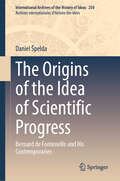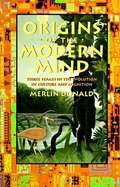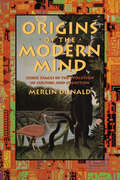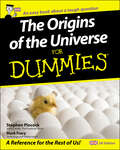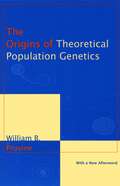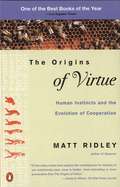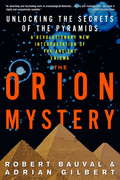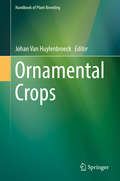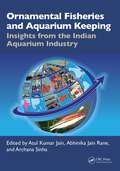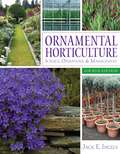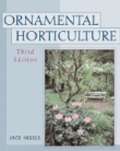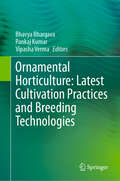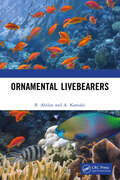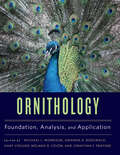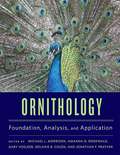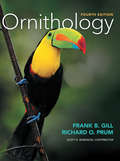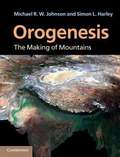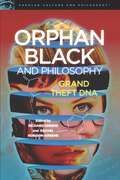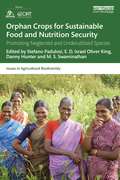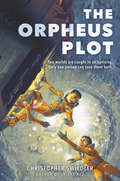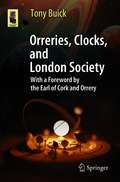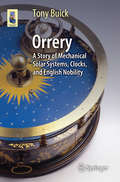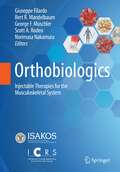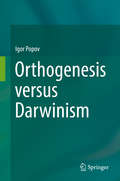- Table View
- List View
The Origins of the Idea of Scientific Progress: Bernard de Fontenelle and His Contemporaries (International Archives of the History of Ideas Archives internationales d'histoire des idées #250)
by Daniel ŠpeldaThis volume offers a new interpretation of the genesis of the idea of scientific progress in early modern science and philosophy. The interpretation argues that the idea of scientific progress was not a historical category, but an epistemological one. The main thesis of the book posits that the idea of scientific progress was a methodological means of dealing with the contingency of nature. To illustrate the novelty of the idea, the individual chapters compare several features of Renaissance natural philosophy with a new regime of knowledge that included time as an inevitable factor of empirical research. The temporal regime of knowledge is illustrated by the work of Bernard de Fontenelle and his colleagues at the Académie des sciences in Paris at the end of the 17th century. The new interpretation remedies a gap in recent scholarship where the idea of scientific progress has been overlooked even though the early modern natural philosophers themselves used it to describe the nature of their research. The book places both well-known texts and less-studied documents in a new light, thus contributing to the lively and rich debate on the origins and nature of early modern science and philosophy. It is of interest to scholars studying the history of early modern philosophy and science.
Origins of the Modern Mind: Three Stages in the Evolution of Culture and Cognition
by Merlin DonaldThis bold and brilliant book asks the ultimate question of life sciences: How did the human mind acquire its incomparable power? Origins of the Modern Mind traces the evolution of human culture and cognition from primitive apes to the era of artificial intelligence, and presents an original theory of how the human mind evolved from its presymbolic form. Illustrated with line drawings.
Origins of the Modern Mind: Three Stages in the Evolution of Culture and Cognition
by Merlin DonaldThis bold and brilliant book asks the ultimate question of the life sciences: How did the human mind acquire its incomparable power? In seeking the answer, Merlin Donald traces the evolution of human culture and cognition from primitive apes to artificial intelligence, presenting an enterprising and original theory of how the human mind evolved from its presymbolic form.
The Origins of the Universe for Dummies
by Mark Frary Stephen PincockDo you want to learn about the physical origin of the Universe, but don't have the rest of eternity to read up on it? Do you want to know what scientists know about where you and your planet came from, but without the science blinding you? 'Course you do - and who better than For Dummies to tackle the biggest, strangest and most wonderful question there is!The Origins of the Universe For Dummies covers:Early ideas about our universeModern cosmologyBig Bang theoryDark matter and gravityGalaxies and solar systemsLife on earthFinding life elsewhereThe Universe's forecast
The Origins of Theoretical Population Genetics: With a New Afterword (Chicago History Of Science And Medicine Chsm (chup) Ser.)
by William B. ProvineTracing the development of population genetics through the writings of such luminaries as Darwin, Galton, Pearson, Fisher, Haldane, and Wright, William B. Provine sheds light on this complex field as well as its bearing on other branches of biology.
The Origins Of Virtue: Human Instincts And The Evolution Of Cooperation
by Matt RidleyIf, as Darwin suggests, evolution relentlessly encourages the survival of the fittest, why are humans compelled to live in cooperative, complex societies? In this fascinating examination of the roots of human trust and virtue, a zoologist and former American editor of the Economist reveals the results of recent studies that suggest that self-interest and mutual aid are not at all incompatible. In fact, he points out, our cooperative instincts may have evolved as part of mankind?s natural selfish behavior--by exchanging favors we can benefit ourselves as well as others. Brilliantly orchestrating the newest findings of geneticists, psychologists, and anthropologists, The Origins of Virtue re-examines the everyday assumptions upon which we base our actions towards others, whether in our roles as parents, siblings, or trade partners. With the wit and brilliance of The Red Queen, his acclaimed study of human and animal sexuality, Matt Ridley shows us how breakthroughs in computer programming, microbiology, and economics have given us a new perspective on how and why we relate to each other.
The Orion Mystery
by Robert Bauval Adrian GilbertA revolutionary book that explains the most enigmatic and fascinating wonder of the ancient world: the Pyramids of Egypt. "[An] absorbing and fascinating work of archaeological detection...clearly and rivetingly told...the book is highly and compulsively readable."--London Sunday Times. 16-page black-and-white inserts.From the Trade Paperback edition.
Ornamental Crops (Handbook Of Plant Breeding Ser. #11)
by Johan Van HuylenbroeckOrnamental plants are economically important worldwide. Both growers and consumers ask continuously for new, improved varieties. Although there are numerous ornamental species, ornamental plant breeding and plant breeding research is mainly limited to some major species. This book focuses on the recent advances and achievements in ornamental plant breeding. The first part of the book focuses on plant traits and breeding techniques that are typical for ornamental plants. Eminent research groups write these general chapters. For plant traits like flower colour or shape, breeding for disease resistance and vase or shelf life are reviewed. General technical plant breeding chapters deal with mutation breeding, polyploidisation, in vitro breeding techniques and new developments in molecular techniques. The second part of the book consists of crop-specific chapters. Here all economically major ornamental species are handled together with selected representative species from different plant groups (cut flowers, pot plants, woody ornamental plants). In these crop-specific chapters, the main focus is on recent scientific achievements over the last decade.
Ornamental Fisheries and Aquarium Keeping: Insights from the Indian Aquarium Industry
by Atul Kumar Jain Abhinika Jain Rane Archana SinhaThis valuable reference book provides an overview of the global aquarium industry, with insights from the Indian aquarium industry. It covers the different aspects of the aquarium industry including the culture of freshwater and marine ornamental fishes, invertebrates, farming of ornamental aquatic plants, manufacturing of aquarium accessories, export-import of ornamental fishes, capacity building, and human resource development, institutional support, and policy framework. It discusses historical review, global and national scenario, future scope, market potential, and policy support required to achieve these goals. The book is meant for professionals in the fisheries industry and academicians in fisheries science.
Ornamental Horticulture: Science, Operations, and Management (4th edition)
by Jack E. IngelsThis comprehensive book is an ideal introduction for both hobbyists and professionals to the art and science of ornamental horticulture providing a balanced coverage of the diverse elements integral to this exciting field and a realistic view of the required business skills while also giving them the chance to develop their creativity.
Ornamental Horticulture: Science, Operations, and Management (3rd edition)
by Jack E. IngelsThis comprehensive text introduces students to both the art and science of ornamental horticulture. The book includes equal coverage of such diverse topics as science, crop production, craftsmanship, and business management skills. From this balanced perspective, the student gains an appreciation for the value of the diverse segments of ornamental horticulture. In addition, the text offers students a realistic view of the business skills required to be successful in ornamental horticulture. Such pedagogical features as extensive illustrations, objectives, and review questions help students monitor their progress. This unique text gives students a well-rounded view of both the art and science of ornamental horticulture to prepare them for careers in this exciting industry.
Ornamental Horticulture: Latest Cultivation Practices and Breeding Technologies
by Bhavya Bhargava Pankaj Kumar Vipasha VermaThis book has combined information on the most recent agricultural practices and breeding methods for ornamental crops. The applications and benefits of hydroponics systems over traditional soil culture growing systems are also discussed. The role of current breeding tactics, such as gene editing tools like CRISPR Cas9, in the development of ornamental crop traits has been debated. The specifics of omics approaches to combat biotic and abiotic stresses in ornamental plants using modern breeding have been thoroughly studied. The critical significance of epigenetic control in ornamental plant development is also highlighted. This book discusses the importance of microbes in sustainable floriculture. Domestication and culture of wild ornamentals have also been considered. This book compiles an in-depth understanding of globally leading cultivated ornamentals and the most important cultivated ornamentals in India. Also, the important domains, i.e., pests and diseases and management in ornamentals and the economic services of ornamental cultivation are discussed. The most recent advances in urban floriculture and the future of smart horticulture have been examined. Nanotechnology uses in ornamental horticulture have been exclusively discussed. This book is a ready reckoner of the advances made in the field of ornamental horticulture for the scientists, graduate students, research scholars, breeders, farmers, and market managers of public and private sectors. This book will establish potential links between inter-disciplinary topics of research, such as aspects of floriculture, plant biotechnology, microbiology, and nanotechnology. This book series will take research in floriculture to a new frontier. This book serves as an excellent guide to formulating public-private collaborative research for future innovation in the floriculture frontiers.
Ornamental Livebearers
by B. Ahilan A. KamaliiThis textbook on Ornamental Livebearers is a comprehensive guide and deals with the culture and breeding of livebearers. The present status of ornamental fish farming and new technologies on the breeding and culture of livebearers have also been aptly dealt with. A wide range of aspects such as, anatomy of livebearers, important livebearers and their breeding, feed and feeding management, water quality management, disease management biosecurity and economics of livebearers fish farm have been described in detail. It is hoped that this publication presented in an easy-to-read style with a number of photographs and illustrations will be of great use to all students who have fisheries in their curriculum and also a standard guide for the researchers, entrepreneurs and ornamental fish farmers.
Ornithologie für Einsteiger und Fortgeschrittene
by Michael WinkDieses Buch widmet sich den faszinierenden Aspekten der Vogelbiologie. Der erste Teil liefert allgemeine Informationen und gibt Hilfestellungen für all jene, die in das Hobby „Vogelbeobachtung“ einsteigen möchten. Für den erfahrenen Vogelbeobachter liefert der zweite Teil des Buches die Grundlagen der wissenschaftlichen Ornithologie. Evolution und Systematik der Vögel, Anatomie und Physiologie, Ernährung, Entwicklung, Verhalten, Zug und Orientierung, Bestandsveränderungen, Neozoen, Gefahren durch Fressfeinde und Krankheiten sowie Vogelschutz werden kurz und prägnant dargestellt. Der Leser lernt die verschiedenen Methoden und Hilfsmittel der Vogelforschung kennen. Eine Vielzahl exzellenter Fotos vieler europäischer Vogelarten und anschauliche Grafiken verleihen diesem Buch einen besonderen Reiz Diese überarbeitete Neuauflage im vergrößerten Format enthält viele neue Fotographien. Sie wurde inhaltlich aktualisiert und mit zahlreichen Links zu interessanten Internetseiten ausgestattet.
Ornithology: Foundation, Analysis, and Application
by Michael L. Morrison, Amanda D. Rodewald, Gary Voelker, Melanie R. Colón, Jonathan F. PratherThe essential text for ornithology courses, this book will leave students with a lifelong understanding and appreciation of the biology and ecology of birds.Aves, the birds, is the wildlife group that people most frequently encounter. With over 10,000 species worldwide, these animals are part of our everyday experience. They are also the focus of intense research, and their management and conservation is a subject of considerable effort throughout the world. But what are the defining attributes that make a bird a bird?Aimed at undergraduate and graduate students, Ornithology provides a solid modern foundation for understanding the life and development of birds. Written by renowned experts from around the globe, this comprehensive textbook draws on the latest research to create an innovative learning experience. Moving beyond bones, muscle, and feathers, it provides the core information needed to "build" the bird, linking anatomy and physiology with ecology and behavior.As it reviews the major orders of birds, the book highlights their wide diversity and critically evaluates ornithological concepts and theories. Incorporating brief biographies of leaders in the field, the text describes their contributions in the context of key historical events in bird science. Each chapter ends with a summary of the material covered, a discussion of potential management and conservation applications, and suggested study questions that will stimulate thought and discussion. Contributors: Peter Arcese, George E. Bentley, Lori A. Blanc, William M. Block, Alice Boyle, Leonard A. Brennan, Luke K. Butler, Zac Cheviron, Luis M. Chiappe, Melanie R. Colón, Caren B. Cooper, Robert J. Cooper, Jamie M. Cornelius, Carlos Martinez Del Rio, John Dumbacher, Shannon Farrell, Maureen Flannery, Geoffrey Geupel, Patricia Adair Gowaty, Thomas P. Hahn, Ashley M. Heers, Fritz Hertel, Geoffrey E. Hill, Matthew Johnson, Lukas F. Keller, Dylan C. Kesler, Pablo Sabat Kirkwood, John Klicka, Christopher A. Lepczyk, Ashley M. Long, Scott R. Loss, Graham R. Martin, John M. Marzluff, Susan B. McRae, Michael L. Morrison, Timothy J. O’Connell, Jen C. Owen, Marco Pavia, Jeffrey Podos, Lars Pomara, Jonathan F. Prather, Marco Restani, Alejandro Rico-Guevara, Amanda D. Rodewald, Vanya G. Rohwer, Matthias Starck, Michael W. Strohbach, S. Mažeika P. Sullivan, Diego Sustaita, Kerri T. Vierling, Gary Voelker, Margaret A. Voss, Jeff R. Walters, Paige S. Warren, Elisabeth B. Webb, Michael S. Webster, Eric M. Wood, Robert M. Zink, Benjamin Zuckerberg
Ornithology: Foundation, Analysis, And Application
by Michael Morrison Jonathan Prather Amanda Rodewald Gary Voelker Melanie ColónAves, the birds, is the wildlife group that people most frequently encounter. With over 10,000 species worldwide, these animals are part of our everyday experience. They are also the focus of intense research, and their management and conservation is a subject of considerable effort throughout the world. But what are the defining attributes that make a bird a bird? Aimed at undergraduate and graduate students, Ornithology provides a solid modern foundation for understanding the life and development of birds. Written by renowned experts from around the globe, this comprehensive textbook draws on the latest research to create an innovative learning experience. Moving beyond bones, muscle, and feathers, it provides the core information needed to "build" the bird, linking anatomy and physiology with ecology and behavior. As it reviews the major orders of birds, the book highlights their wide diversity and critically evaluates ornithological concepts and theories. Incorporating brief biographies of leaders in the field, the text describes their contributions in the context of key historical events in bird science. Each chapter ends with a summary of the material covered, a discussion of potential management and conservation applications, and suggested study questions that will stimulate thought and discussion.
Ornithology: Michelangelo, Florence, And The David 1492-1504
by Richard Prum Frank GillOrnithology, 4th Edition is a comprehensive introductory text covering a wide scope of topics essential for understanding the field of ornithology. This new edition infuses the most current research and a more conceptual approach alongside an evolutionary perspective. The 4th edition retains its hallmark readability, as well as a well updated narrative and bibliography with the latest scientific content and references. The 4th edition will be the first in full color in both art and design and will include over 400 color photographs. The updated design is clean, colorful, approachable, and easy to use as a narrative or study reference. New pedagogical elements reinforce key concepts new end of chapter assessment questions allow students to evaluate their learning. The 4th edition is the best yet, during both a student’s first read, and when revisited as a reference.
Orogenesis: The Making of Mountains
by Michael R. Johnson Simon L. HarleyOrogenesis, the process of mountain building, occurs when two tectonic plates collide - either forcing material upwards to form mountain belts such as the Alps or Himalayas or causing one plate to be subducted below the other, resulting in volcanic mountain chains such as the Andes. Integrating the approaches of structural geology and metamorphism, this book provides an up-to-date overview of orogenic research and an introduction to the physico-chemical properties of mountain belts. Global examples are explored, the interactioning roles of temperature and deformation in the orogenic process are reviewed, and important new concepts such as channel flow are explained. This book provides a valuable introduction to this fast-moving field for advanced undergraduate and graduate students of structural geology, plate tectonics and geodynamics, and will also provide a vital overview of research for academics and researchers working in related fields including petrology geochemistry and sedimentology.
Orphan Black and Philosophy
by Richard Greene Rachel Robison-GreeneIn Orphan Black, several apparently unconnected women discover that they are exact physical doubles, that there are more of them out there, that they are all illegally produced clones, and that someone is having them killed. They find themselves in the midst of a secret and violent struggle between a fundamentalist religious group, a fanatical cult of superhuman biological enhancement, a clandestine department of the military, and a giant biotech corporation. Law enforcement is powerless and easily manipulated by these sinister forces. The clones are forced to form their own Clone Club, led by the resourceful Sarah Manning, to defend themselves against their numerous enemies and to find out exactly where they came from and why. <p><p> Orphan Black continually raises philosophical issues, as well as ethical and policy questions deserving philosophical analysis. What makes a person a unique individual? Why is it so important for us to know where we came from? Should we have a say in whether a clone is made of us? Is it immoral to generate clones with built-in health problems or personality defects - and if so, does that mean that producers of clones must practice eugenic selection? What light does the behavior of members of the Clone Club shed on the nature-nurture debate? Is it relevant that most are heterosexual, one is a lesbian, and one is a transgender male? <p> This TV show shows us problems of biotechnology which will soon be vital everyday issues. But what kind of a future faces us when human clones are commonplace? Will groups of human clones have a tight bond of solidarity making them a threat to democracy? If the world is going to be taken over by an evil conspiracy, would it better be a scientific cult like Neolution or a religious cult like the Prolethians? Should biotech corporations be able to own the copyright on human DNA sequences? What rules of morality apply when you can't trust the police and powerful groups are ready to murder you?
Orphan Crops for Sustainable Food and Nutrition Security: Promoting Neglected and Underutilized Species (Issues in Agricultural Biodiversity)
by Danny Hunter Stefano Padulosi E.D. Israel Oliver King M. S. SwaminathanOrphan Crops for Sustainable Food and Nutrition Security discusses the issues, challenges, needs and opportunities related to the promotion of orphan crops, known also as neglected and underutilized species (NUS). The book is structured into six parts, covering the following themes: introduction to NUS, approaches, methods and tools for the use enhancement of NUS, integrated conservation and use of minor millets, nutritional and food security roles of minor millets, stakeholders and global champions, and, building an enabling environment. Presenting a number of case studies at the regional and country levels, the chapters cover different but highly interlinked aspects along the value chains, from acquisition and characterization of genetic diversity, cultivation and harvesting to value addition, marketing, consumption and policy for mainstreaming. Cross-cutting issues like gender, capacity building and empowerment of vulnerable groups are also addressed by authors. Representatives from communities, research for development agencies and the private sector also share their reflections on the needs for the use enhancement of NUS from their own perspectives. This book will be of great interest to students and scholars of food security, sustainable agriculture, nutrition and health and development, as well as practitioners and policymakers involved in building more resilient food and production systems.
The Orpheus Plot
by Christopher SwiedlerA rebellion in space pits one boy’s past against his future in this gripping adventure from the critically acclaimed author of In the Red! This out-of-this-world story about fighting for what’s right, chasing your dreams, and believing in yourself is perfect for fans of Kevin Emerson, Yoon Ha Lee, and D. J. MacHale.Lucas Adebayo grew up on a small mining ship in the asteroid belt, but wants to join the Navy and become the best pilot in the galaxy. The Navy has never accepted a Belter cadet before, but Lucas’s skills secure him a place on the training ship, the Orpheus.Life in the Navy couldn’t be more different than life in the Belt, and Lucas struggles to find his place. As a Belter, he’s an outsider among his peers; as a Navy cadet, he doesn’t quite fit in at home anymore, either. Lucas is caught between the worlds of his past and his future when a Belter rebellion puts everyone’s lives at risk. Only he can lead the way to peace.Praise for In the Red“It will leave you breathless.”—New York Times bestselling author D. J. MacHale“A non-stop, pulse-pounding adventure!”—Kevin Emerson, author of Last Day on Mars“Stunning descriptions and harrowing feats of survival.”—Booklist
Orreries, Clocks, and London Society: The Evolution of Astronomical Instruments and Their Makers (Astronomers' Universe)
by Tony BuickOrreries—mechanical models of the Solar System and its motions—are found everywhere. They appear in paintings, on computers, across natural landscapes, and in museums all over the world. The more you look, the more you find, yet their significance is often overlooked aside other great astronomical inventions.This book reclaims the history of the orrery, offering a fascinating look into its evolution over the centuries. With a particular focus on London society and clockmakers, it weaves together historical narrative with practical know-hows and scientific fact, showing how the orrery changed from a fanciful toy to a high-tech instrument to a vessel for art and education. The first edition, Orrery, explained what an orrery is and how it got its name. This revised edition goes several steps further, tracing the instrument back to the time of Ptolemy and forward to planetariums and star projectors. In addition, it features new sections on how to construct your own orrery at home.This book will appeal to anybody interested in astronomical mechanical devices, scientific instruments, horology, or the history of clocks.
Orrery
by Tony Buick"Orrery" appeals to almost anyone interested in popular astronomy, astronomical mechanical devices, scientific instruments, the history of clocks - and even the history of aristocratic and prestigious families! Many people these days - not only astronomers - have a good idea of the main components of the Solar System. They might also know about the orrery, a mechanical model that shows the movements of the Moon and planets. But not too many know why it was so named and who it was named after. The Boyle family - the Earls of Orrery -include the famous Boyle of Boyle's Law. But others were key in the history of the orrery, not the least being clockmakers. Aware of the lunar and planetary content of the sky, they strove to make scientific instruments to demonstrate their movements and introduced measuring devices to predict their positions. In antiquity, their lives on occasion depended on the accuracy; upsetting kings and lords was dangerous business! Orreries are found everywhere. They can be made of wood or metal, and are even available today as home-assembly kits and children's toys. They appear in paintings, on computers, on the side of royal clocks, in stately home hallways, and of course, in museums all over the world. This book contains illustrations of orreries to give a guide as to what is and was available and where to see the best examples. It also contains information and references to help readers who want to make (or buy) their own orrery. The story of the Boyles is not just relevant to a tiny corner of Ireland, but spans the world. "Orrery" highlights the process of discovery and humankind's universal fascination with the heavens. Provides a fascinating example of the relationship between innovative thinking (invention) and precision engineering (execution).
Orthobiologics: Injectable Therapies for the Musculoskeletal System
by Giuseppe Filardo Bert R. Mandelbaum George F. Muschler Scott A. Rodeo Norimasa NakamuraThis book presents the evidence related to the use of injectable biologics to provide faster and better healing for musculoskeletal lesions and conditions. The authors discuss approaches, such as blood derivatives and cell concentrates, applied to lesions of muscles, ligaments, tendons, bones, meniscus and cartilage, as well as osteoarthritis. Chapters are written by some of the most influential opinion leaders in the field, with up-to-date review of the current literature, where the authors explore both the potential and the limitations of these minimally invasive and promising treatments.The first section is devoted to the formulations and rationale for the use of injectable orthobiologics, while the second section reviews current treatment methods applied to specific joints and pathologies – ranging from tendinopathies through non-unions to articular degenerative processes – as well as the results of these treatment approaches. The third section explores future perspectives, such as pluripotent stem cells, gene therapy, and the stimulation of intrinsic stromal cell niches. Appealing to a broad readership, this book will be of interest to both laboratory research scientists and clinicians, including orthopedists, sports physicians, physiatrists, and regenerative medicine experts.
Orthogenesis versus Darwinism
by Igor PopovThis book reviews the convoluted history of orthogenesis with an emphasis of non-English sources, untangles relationships between various concepts of directed evolution and argues whether orthogenesis has something to offer modern biology. Darwinism claims that evolution occurs by selection from an extensive random variability. An alternative viewpoint—that the material for variability is limited and organisms are predisposed to vary in certain directions—is the essence of evolutionary concepts that can be grouped together under the name of orthogenesis. Dating back to Lamarck, orthogenesis has existed in many guises. Branded as mystical and discarded as unscientific, it keeps re-emerging in evolutionary discussions.
